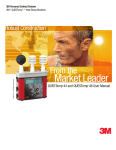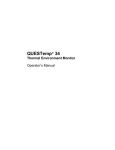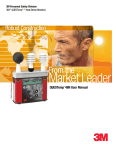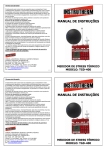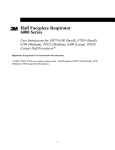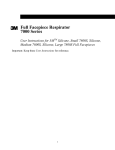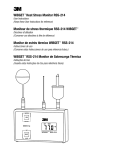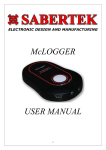Download 3M WIBGET WB-300 Portable Heat Stress Monitor User Manual
Transcript
3M Occupational Health and Environmental Safety Division 3MTM WIBGET TM Heat Stress Monitor WB-300 WIBGET WB-300 User Manual i Dangers, warnings and cautions 3MTM WIBGETTM Heat Stress Monitor WB-300 User Manual Dangers, warnings and cautions Danger! Failure to observe the following procedures may result in serious personal injury •This instrument is not intrinsically safe, do not use in hazardous locations. Warning! Failure to observe the following procedures could damage the instrument • Read the manual before operation. • Do not store in temperatures exceeding 100°C (212 °F) • Do not immerse in liquids. • Condensation may damage your instrument. • Substitution of components may impair the accuracy of the instrument. Repair should be completed by authorized service personnel only. Caution! General • Replacement of 9-V alkaline battery only in a non-hazardous locations. • If recharging with a NiHM Battery pack, recharge only in a non-hazardous environment. • A non-condensing environment is required for proper measurements. • Do not charge battery outside the range of 0°C to 40°C (32°F to 104°F). • Battery run-time may be reduced when operating at lower than 0°C (32°F) temperatures. Intended Use The WIBGET WB-300 is intended to measure environmental temperatures for heat stress analysis. Consult your company’s safety professional for local standards, or call 3M at 1-800-243-4630. ii Table of Contents Table of Contents Up and Running�������������������������������������������������������������������������������������������������������������������������3 Check wick and fill natural wet bulb������������������������������������������������������������������������������������������3 Keypad Operation����������������������������������������������������������������������������������������������������������������������4 Sensors �������������������������������������������������������������������������������������������������������������������������������������5 Natural Wet Bulb Thermometer ������������������������������������������������������������������������������������������������5 Globe Thermometer �����������������������������������������������������������������������������������������������������������������5 Dry Bulb Thermometer �������������������������������������������������������������������������������������������������������������5 Measurements���������������������������������������������������������������������������������������������������������������������������6 Wet Bulb Globe Temperature ���������������������������������������������������������������������������������������������������6 Displayed Data��������������������������������������������������������������������������������������������������������������������������6 Setup������������������������������������������������������������������������������������������������������������������������������������������7 Placing the WB-300 on-site for monitoring/testing�������������������������������������������������������������������7 Operational Check���������������������������������������������������������������������������������������������������������������������8 Power Options���������������������������������������������������������������������������������������������������������������������������8 9-V Alkaline Battery Replacement ������������������������������������������������������������������������������������������8 NiMH Battery Pack ������������������������������������������������������������������������������������������������������������������������8 Appendix A: Specifications ������������������������������������������������������������������������������������������������������9 Measurements ��������������������������������������������������������������������������������������������������������������������������9 Languages���������������������������������������������������������������������������������������������������������������������������������9 Housing��������������������������������������������������������������������������������������������������������������������������������������9 Size��������������������������������������������������������������������������������������������������������������������������������������������9 Weight ��������������������������������������������������������������������������������������������������������������������������������������9 Sensor Types�����������������������������������������������������������������������������������������������������������������������������9 Accuracy �����������������������������������������������������������������������������������������������������������������������������������9 Operating Temperature Range��������������������������������������������������������������������������������������������������9 Power Options ��������������������������������������������������������������������������������������������������������������������������9 Battery Life ��������������������������������������������������������������������������������������������������������������������������������9 Charge Time (NiMH Battery Pack) �������������������������������������������������������������������������������������������9 Safety Approvals and Special Conditions���������������������������������������������������������������������������������9 Appendix B: Heat Exposures Tables���������������������������������������������������������������������������������������10 ACGIH��������������������������������������������������������������������������������������������������������������������������������������10 PHEL Curves (Total Exposure Time in Hours: Minutes)�������������������������������������������������������� 11 Product Information�����������������������������������������������������������������������������������������������������������������12 Accessories�����������������������������������������������������������������������������������������������������������������������������12 Warranty����������������������������������������������������������������������������������������������������������������������������������12 Contact/Service information����������������������������������������������������������������������������������������������������12 ������������������������������������������������������������������������������������������������������������������������������������������������12 Figures Figure 1: Wet bulb and maintenance ..........................................................................................4 Figure 2: Keypad keys identified..................................................................................................5 Figure 3: Sensors identified..........................................................................................................6 Figure 4: Data/measurement screen examples..........................................................................7 Figure 5: NiMH Battery Pack......................................................................................................9 1 Up and Running Up & Running Up and Running 1. Ensure the wet bulb’s wick is clean. Then, fill the reservoir with distilled water. 2. Place the WB-300 in the work area in a safe location approximately 3.5 feet off the ground. 3. Turn the instrument On by pressing I/O Enter key. • If the battery voltage displayed during the power-on sequence is less than or equal to 6.4 volts, replace or recharge the batteries. 4. Using the Arrow keys, select the desired measurement/parameter screen. 5. Allow 10 minutes for the sensors to stabilize to the environment before taking readings. Check wick and fill natural wet bulb The WB-300 uses a cotton wick immersed into a reservoir containing distilled water. Ordinary tap water should not be used, as the contaminants that are left behind after evaporation will shorten the life of the wick and cause high readings. If the wick is discolored it should be replaced. To replace the wick, slide the old wick off the top of the sensor. Place a new wick over the sensor, making sure that the bottom of the wick is down in the reservoir. Filling wet bulb reservoir 1. Remove reservoir cover and fill with distilled or de-ionized water. 2. Replace reservoir cover. Wick Reservoir cover Reservoir Figure 1: Wet bulb and maintenance 2 Keypad Operation Keypad Keypad Operation The unit operates using a membrane keypad with 4 keys. The key responds when the key is released while all other keys respond when the key is pressed. Keys I/O Enter Explanation The key is used to turn on and off the instrument and to enter setup changes. Turning on: Press and release the I/O enter key to power on. The Instrument name (WIBGET), revision number, and battery information appears during start-up. Turning off: Hold the I/O key down while a count-down 3-2-1 occurs in the lower left hand corner of the display. Enter setup changes: While in Setup screen, press to enter (or select) setup changes. Setup The key allows changing the setup parameters. Two parameters are available: Celsius or Fahrenheit and language selection. Setup: Press setup to access the parameters. Use the arrow keys to switch between the two parameters. Press the enter key to change the parameters. Press setup again to exit. Up Arrow The key changes which items appear on the display. Scrolls up. Down Arrow The key changes which items appear on the display. Scrolls down. I/O Enter key Setup key Figure 2: Keypad keys identified Up Arrow Down Arrow 3 Sensors Sensors Sensors Natural Wet Bulb Thermometer The natural wet bulb thermometer gives an indication of the effects of humidity on an individual. Relative humidity and air flow are taken into account by measuring the amount of evaporative cooling taking place at a thermometer covered with a moistened wick. The WB-300 uses a cotton wick immersed into a reservoir containing distilled water. Ordinary tap water should not be used, as the contaminants that are left behind after evaporation will shorten the life of the wick and cause high readings. If the wick is discolored it should be replaced. To replace the wick, slide the old wick off the top of the sensor. Place a new wick over the sensor, making sure that the bottom of the wick is down in the reservoir. Globe Thermometer The globe thermometer gives an indication of the radiant heat exposure on an individual due to either direct light or hot objects in the environment. This is accomplished by placing a temperature sensor inside a blackened copper sphere and measuring the temperature rise. The WBGT index is based on the response of a 6 inch diameter globe. The WB-300 uses a 2 inch diameter globe for a faster response time. The temperature of the 2 inch globe is correlated to match that of a 6 inch globe. As an option, a sensor array with a 6 inch diameter globe is available. As an option, a sensor array with a 6 inch diameter globe is available. Dry Bulb Thermometer The dry bulb thermometer measures the ambient air temperature. This measurement is used in the outdoor WBGT calculation when a high solar radiant heat load may be present. The series of white plates surrounding the sensor shield it from radiant heat. A B C A. Globe thermometer B. Natural wet bulb thermometer C. Dry bulb thermometer Figure 3: Sensors identified 4 Measurements Measurements Measurements The WB-300 portable heat stress monitor computes the Wet Bulb Globe Temperature (WBGT). The WBGT is an accepted measurement for determining the heat stress level imposed on an individual in a given environment. The WB-300 measures three parameters: • Ambient or dry bulb temperature (DB) • Natural wet bulb temperature (WB) • Globe temperature (G) Wet Bulb Globe Temperature The WBGT is a weighted average of the three temperature sensors using the following formulas: WBGT (indoor) = 0.7 WB + 0.3G (denoted as "WBGTi" on the display) WBGT (outdoor) = 0.7WB + 0.2G + 0.1DB (denoted as "WBGTo" on the display) ;; NOTE: The resulting WBGTi/WBGTo can be compared to indices of work-rest regimens (or stay times) based upon the work loads. Please see Appendix B for published heat exposure tables. Displayed Data When powered on, the previously viewed measurement screen will be displayed. To view data screens, press the or keys. Data Screens The following four screens are viewable by pressing the or keys on the WB-300. Wet/Dry Measurement screen WBGTi/WBGTo Measurement screen Globe Measurement screen Battery screen Figure 4: Data/measurement screen examples 5 Setup Setup Setup While powered on, press the setup key to change the temperature units (oF/oC) or the language settings (English, Spanish, French, Italian, or German), if desired. Placing the WB-300 on-site for monitoring/testing The WB-300 should be placed at a height of 3.5 feet (1.1m) for standing individuals or 2 feet (.6m) for seated individuals. Tripod mounting is recommended to get the unit away from anything that might block radiant heat or airflow. A 1/4"x20 threaded bushing on the bottom of the instrument allows mounting to a standard photographic tripod. Do not stand close to the unit during sampling. Make sure that the wet bulb reservoir is filled with distilled water and that the cotton wick is clean and fully wetted. After adding water or placing the unit in a new environment, allow ten minutes for the globe and wet bulb readings to stabilize. A series of dashes appear in the display if one of the following occur: • The temperature is outside of its allowable range • A temperature sensor has failed Operational Check A verification module, 3M ID: 70071581246, may be used to check the operation of the WB-300. Remove the top sensor bar and plug the verification module into the top of the unit. With the WB-300 set to read in degrees Celsius, verify that the displayed readings match those printed on the module within +/-0.5oC. If the readings are not within the +/-0.5oC tolerance, then have the unit serviced and calibrated. 6 Power Options Power Options Power Options There are 3 options for powering the WB-300: a 9-volt alkaline battery, a NiMH (Nickel Metal Hydride) rechargeable 6-cell battery pack, and an AC adapter. A door on the back of the instrument allows the user access to the 9-volt battery. The rechargeable battery pack is located inside of the unit. If the rechargeable battery pack ever needs to be replaced, it can be accessed by removing the screws from the bottom panel of the unit. The 2-position switch located in the battery compartment must be set by the user if the power supply method is changed. The up position is for the 9-volt battery. The down position allows for either the AC adapter or the rechargeable batteries. The AC adapter will trickle charge the rechargeable batteries if they are in place or it will simply allow for line power operation of the unit. 9-V Alkaline Battery Replacement The 9-volt battery should be replaced or the NiMH battery pack should be recharged when the voltage drops below 6.4 volts. The battery voltage is displayed when the instrument is turned on. While turned on, the battery voltage can be displayed at any time by pressing the up or down arrow keys to move through the display until the battery voltage screen appears. If, while operating, the battery voltage drops below 6.4 volts, the display will automatically switch to the display showing the battery voltage along with a low battery message. After a low battery occurs, the unit will continue to operate for approximately 8 hours. When the battery voltage falls to 6.2 volts or below, the unit will automatically turn off. NiMH Battery Pack The NiMH rechargeable battery pack is charged in the instrument using 120VAC to 9VDC adapter. A discharged battery pack requires a charge of 16 hours. Leaving the AC adapter plugged in for extended lengths of time or when operating the instrument will not harm the rechargeable batteries. NiMH Battery Pack To install, slide into case and plug in connector as shown. Figure 5: NiMH Battery Pack 7 Appendix A: Specifications Specifications Appendix A: Specifications Measurements • Globe, dry bulb, wet bulb, WBGTi, (WBGT indoor) and WBGTo (WBGT outdoor). • Temperatures given in Celsius or Fahrenheit. Languages English, French, Spanish, Italian, German. Housing Designed water resistant to a light rain or mist. If rain is frequent, best practice would be to remote the sensor bar and keep the instrument sheltered. (Note: when top sensor bar is removed, an optional cable can be attached to measure remotely.) Size Height 9.2in (23.5cm); Width 7.2in (18.3mm); Depth 3.0in (7.5mm) Dimensions include mounted sensor assembly. Weight 2.6 lbs. (1.2 kg) with mounted sensor assembly. Sensor Types Temperature: 1000 ohm platinum RTD Accuracy Temperature: +/-0.5oC between 0oC to 100oC (+/- 0.9o F between 32o F to 212oF) Operating Temperature Range o o o Sensor Assembly: -5 C to 100 C (23 F to 212oF) Electronics: -5oC to 60oC (23o F to 140o F) Power Options 9V alkaline, 7.2V NiMH rechargeable pack (charged in the unit), or AC adapter wall power cube (AC adapter will power the unit or recharge the NiMH battery pack). Battery Life 9V alkaline: 140 hours Rechargeable Nickel Metal Hydride: 300 hours Charge Time (NiMH Battery Pack) 16 hours (charge in the unit) Safety Approvals and Special Conditions CE mark Compliance with Essential Health and Safety Requirements has been assured by compliance with: EN 50014 : 1997 and EN 50020 : 2002 The year of manufacture is determined by the third character in the instrument’s serial number. “A” was manufactured in 2001, “B” in 2002, “C” in 2003, “D” in 2004 and so forth. Appendix B 8 Appendix B: Heat Exposures Tables Appendix B: Heat Exposures Tables ACGIH Screening Criteria for Heat Stress Exposure. WBGT values in oC. • NOTE: according to the ACGIH’s guidelines, the temperature values represent a work and rest process which is explained in the standards. Please refer to the ACGIH TLV’s and BEIs for specific details. Work and recovery (TLV ) Light Moderate Heavy Very Heavy 75% to 100% 31.0 28.0 26.0* 23.5* 50% to 75% 31.0 29.0 27.5 25.5* 25% to 50% 32.0 30.0 29.0 28.0 0% to 25% 32.5 31.5 30.5 30.0 Work and recovery (Action Limit) Light Moderate Heavy Very Heavy 75% to 100% 28.0 25.0 22.5* 20.0* 50% to 75% 28.5 26.0 24.0 22.5* 25% to 50% 29.5 27.0 25.5 24.5 0% to 25% 30.0 29.0 28.0 27.0 *Values not specified by ACGIH have been estimated for continuity. Cited from "American Conference of Governmental Industrial Hygienists - Threshold Limit Values and Biological Exposure Indices for 2008"; Reprinted with permission from ACGIH 9 PHEL Curves PHEL Curves (Total Exposure Time in Hours: Minutes) WBGT (oF) I II III IV V VI 80.0 >8:00 >8:00 >8:00 8:00 6:35 4:30 81.0 >8:00 >8:00 >8:00 8:00 6:35 4:30 82.0 >8:00 >8:00 8:00 7:05 5:25 3:40 83.0 >8:00 8:00 7:45 6:25 4:55 3:20 84.0 >8:00 8:00 7:05 5:55 4:30 3:05 85.0 8:00 7:45 6:30 5:20 4:05 2:50 86.0 8:00 7:05 5:55 4:55 3:45 2:35 87.0 7:25 6:30 5:25 4:30 3:25 2:20 88.0 6:45 5:55 4:55 4:05 3:10 2:10 89.0 6:10 5:25 4:30 3:45 2:50 2:00 90.0 5:40 5:00 4:10 3:25 2:40 1:50 91.0 5:15 4:35 3:50 3:10 2:25 1:40 92.0 4:50 4:10 3:30 2:55 2:15 1:30 93.0 4:25 3:50 3:15 2:40 2:00 1:25 94.0 4:05 3:35 3:00 2:25 1:50 1:15 95.0 3:45 3:15 2:45 2:15 1:45 1:10 96.0 3:25 3:00 2:30 2:05 1:35 1:05 97.0 3:10 2:45 2:20 1:55 1:25 1:00 98.0 2:55 2:35 2:10 1:45 1:20 0:55 99.0 2:40 2:20 2:00 1:40 1:15 0:50 100.0 2:30 2:10 1:50 1:30 1:10 0:45 101.0 2:20 2:00 1:40 1:25 1:05 0:45 102.0 2:10 1:50 1:35 1:15 1:00 0:40 103.0 2:00 1:45 1:25 1:10 0:55 0:35 104.0 1:50 1:35 1:20 1:05 0:50 0:35 105.0 1:40 1:30 1:15 1:00 0:45 0:30 106.0 1:35 1:25 1:10 0:55 0:45 0:30 107.0 1:30 1:15 1:05 0:50 0:40 0:25 108.0 1:20 1:10 1:00 0:50 0:35 0:25 109.0 1:15 1:05 0:55 0:45 0:35 0:25 10 Product Information Product Information • WIBGET WB-300 Heat Stress Monitor kit, includes 9V alkaline battery, replacement wicks, water bottle, verification module, storage case, and user manual. (3M ID: 70-07160781-9) Accessories Product No. Description 3M ID 056-795 3MTM Sensor array with 2 inch globe (one included) 70-0715-8658-3 056-780 3M Sensor array with 6 inch globe (one included) 70-0715-8656-7 015-910 3MTM 120VAC to 9VDC transformer/power adapter 70-0715-8174-1 015-680 3MTM 220VAC to 9VDC transformer/power adapter 70-0715-8507-2 059-045 3MTM Tripod 70-0715-8374-7 056-679 3M Replacement wicks 70-0715-8373-9 053-923 3MTM Verification module 70-0715-8124-6 056-068 3MTM 2 oz water bottle 70-0715-8371-3 TM TM Warranty 3M™ WIBGET™ WB-300 LIMITED WARRANTY. 3M warrants the WIBGET WB-300 will be free from defective materials and workmanship for one year from date of purchase (indicated on the sales receipt), provided it is maintained and used in accordance with 3M™ instructions and/or recommendations. If any component becomes defective during the warranty period, it will be replaced or repaired free of charge. This warranty does not apply to units that have been altered or had repair attempted, or that have been subjected to abuse, accidental or otherwise. The above warranty is in lieu of all other express warranties, obligations or liabilities. THE IMPLIED WARRANTIES OF MERCHANTABILITY AND FITNESS FOR PARTICULAR PURPOSE ARE LIMITED TO one year FROM THE PURCHASE DATE. 3M™ shall not be liable for any other warranty, express or implied, arising out of or related to the appropriate use of environmental temperature measurement data for heat stress related issues. Manufacturer or its agent’s liability shall be limited to replacement or repair as set forth above. Buyer’s sole and exclusive remedies are return of the goods and repayment of the price, or repair and replacement of defective goods or parts. Contact/Service information In United States, contact: Website: 3M.com/Detection Technical Assistance: 1-800-243-4630 For other 3M products: 1-800-3M HELPS Or 1-651-737-6501 ©2011 3M Company 3M Occupational Health and Environmental Safety Division 3M Center Building 0253-02-W-70 St. Paul, MN 55144-1000 Occupational Health & Environmental Safety Division 3M Center Building 0235-02-W-70 St. Paul, MN 55144-1000 3M.com/detection Technical Service: 1 800 243 4630 Customer Service:1 800 328 1667 3M.com/OccSafety Please recycle. Printed in U.S.A. 3M and WIBGET are trademarks of 3M Used under license in Canada © 2011 3M Company All rights reserved. 34-8706-7556-7
















